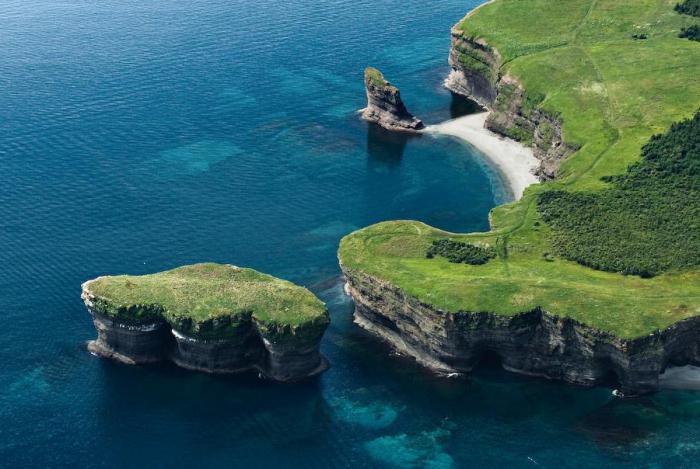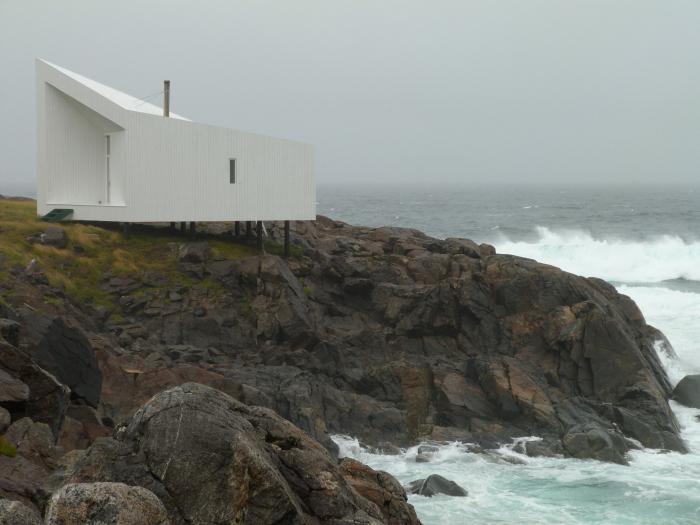The name of the island of Newfoundland in English means "newfound land." It is located in the North Atlantic, off the east coast of Canada. The narrow Strait of Bell-Ile separates it from the southern edge of the Labrador Peninsula, in the East Newfoundland is washed by the Atlantic Ocean, in the West - St. Lawrence. Ancestors of the Indians began to populate it in the 1st century, and Europeans - ten years after the discovery of America by Columbus. But neither one nor the other was able to conquer it, and the island still retains its wild pristine appearance, giving way to people only a small part of its vast territories.
First Europeans
There is historical evidence confirming that the Norman Vikings visited the island of Newfoundland back in the 11th century. Historians believe that it is the Icelandic sagas called him Vinland, and the Labrador Peninsula - Markland. Folklore may embellish reality, but on the island of Newfoundland, the remains of a Norman village have survived, which are a local attraction and are protected by UNESCO as the first European settlement in the Western Hemisphere.
Already in those distant times, this place was not deserted: the ancestors of the Indians and Eskimos lived here, with whom the Vikings carried on trade, thinking little about geographical discoveries. This fever began later.
Century of great travels
It would not be a mistake to say that the island of Newfoundland and the coast of the Labrador Peninsula opened the invincible spirit of self-interested European curiosity. In the second half of the XV century, among the powerful powers of the current EU, a fashion appeared to travel to India through the Western Hemisphere. The first known Columbus went in search of all and came across a new continent - the Spaniards found the richest colonies.
Having learned of such unheard of successes, the Bristol merchants decided to equip their own expedition - the hope of reaching blessed lands full of gold and precious spices, still intoxicated many heads. Since no support from the state, except for the blessing of the English king Henry VII, was obtained, the enterprise could not boast of a wide scope.
Discovery of Newfoundland
In May 1497, a ship under the command of an English navigator of Italian origin John Cabot (Giovanni Cabot), who, by and large, discovered Newfoundland Island for Europeans, set sail from Bristol's marina. The ship was called "Matthew", and there were only 18 crew members on board - apparently, the organizers did not count on rich loot, and the purpose of the expedition was only to reconnoiter the area. After spending a little more than a month in the ocean, Cabot reached the north coast of Newfoundland in June 1497. Stepping to the ground and declaring it the possessions of the English crown, the traveler went further along the coast, opened the Big Newfoundland Bank, rich in fish, "wandered" around the island for about a month, turned back and arrived in England on August 6.

The information brought by Cabot was not at all encouraging: gloomy, cold, there is nothing but fish. I must say that the reports of travelers of those years are covered with a darkness of mystery - no one wanted to share information, fearing the machinations of competitors. Therefore, the remaining evidence is extremely scarce. Whether
John Cabot Labrador has reached or not is not known for certain.
Territorial disputes
The Portuguese outdid the British in this matter: the peninsula got its name from the name of Hoyo Fernandez Lavrador (“lavradore” - from Portuguese. Landowner). In 1501, his compatriots, led by Gaspard Kortereal, arrived in Newfoundland. The monument to this sailor still stands on one of the squares of St. John's, the provincial capital (in 1965, the statue was presented by the Portuguese, nostalgic for their great maritime past).
For a long time no one claimed seriously on the territory of Newfoundland, its indigenous tribes of Indians and Eskimos, as well as visiting Portuguese, French, Irish and British, inhabited it. They traded with the locals, exchanging valuable beaver skins, otters and other fur animals from them, engaged in fishing and hunting.
At the end of the XVI century, in the south-west, whales hunted and fished, and in the Northeast, the British were engaged in trade. The ownership of the island was sluggishly disputed by various European states.
The possession of the British crown
In 1701, the Spanish king died - the last of the Habsburg dynasty. In Europe, a war broke out for the Spanish inheritance, lasting for 13 years. In 1713, under the terms of the Utrecht Peace, Newfoundland went to Britain.
However, this was not the end: during the seven-year war (1756-1763) France, Spain and Britain again began to challenge each other's territory, and in 1762, an Anglo-French battle took place near St. John, in which the British won, than finally secured their rights.
Canadian Confederation Claims
Canada attempted to lure the island into its political and economic influence, but Newfoundland reacted without any particular enthusiasm. In 1869, the proposal to join the Canadian Confederation was flatly rejected. After, by order of London, the Labrador Peninsula was annexed to Newfoundland, Canada offered to help develop local iron deposits and again refused: the islanders rightly believed that, having become economically dependent on the confederation, they would inevitably lose their sovereignty. However, what to be, that cannot be avoided.
In the 30s, a global crisis erupted, which led to the collapse of the economy of the island of Newfoundland. London introduced an “external administration”, a special commission was created to determine the future fate of the island. After the end of World War II, the decision was made and
implemented. In 1948, according to the results of the referendum, Newfoundland Island became one of the
provinces of Canada, which it is to this day.
Population and climate
Today, the population of these places totals about 500 thousand people. Given that the area of the island is about 111.39 thousand square kilometers, the population is more than modest. The settlements are mainly located on the coast, since for a long time fishing was the main means of subsistence for local residents.
Cool dampness has long declared rights to the island of Newfoundland, whose climate was considered "terrible" even by the British.
In summer, in the Southeast, the temperature does not exceed 15 ° C, however, the proximity of the Atlantic determines rather warm winters - rarely it is colder -4 ° C. In the North-West, the temperature regime is sharper: in the summer up to 25 ° C, and in the winter there are ten degrees of frost.
The relief of different parts of Newfoundland is also different. In the West, the area is mountainous, the local Long Range Range is considered part of the Appalachian Mountains (once the island broke away from the prehistoric mainland as a result of a terrible geological cataclysm). In the place where the island of Newfoundland is located, the warm waters of the Gulf Stream meet the cold Labrador Current. This leads to a significant amount of precipitation on the island (75-1500 mm). Due to the collision of water and air currents of different temperatures for almost a third of the year, white fluffy clouds occupy the island of Newfoundland. The photo of the swirling haze through which the roofs of St. John's are peeping through, reminiscent of scenes from Stephen King's Mist.
Local inhabitants
King monsters, fortunately, are not found on the island. But quite terrestrial animals live, thriving due to the fact that this province of Canada is by far the least affected by industrialization. Most of the island of Newfoundland is covered by pristine taiga, significant areas are swampy. There are moose, bears, lynxes, raccoons, foxes and many other animals. Rugged by numerous fjords and rocky bays, the coast is a true paradise for birds and marine mammals.
Tourism
The opportunity to walk around untouched places attracts many ecotourism fans. In the Gros Morne National Park, they find an abundance of wild coastal cliffs, the beauty of transparent mountain lakes and stormy rapids. From the steep banks, you can admire drifting icebergs and migrating blue whales.
It offers tourists an ancient Viking settlement, the oldest city street in North America (Water Street), museums, restaurants and souvenir shops.
Sports fishing enthusiasts also come here: the local waters are still teeming with fish, despite the fact that it has been actively caught on an industrial scale almost since the discovery of the islands of Newfoundland and Labrador. The irresponsible attitude to the natural treasure almost ruined this land.
"Fish place"
Big Newfoundland Bank - a shallow area of 282.5 thousand square meters. km, which is still the richest "deposit" of fish in the world. Uncontrolled trapping lasted for centuries: in the 19th century, the population of Newfoundland increased from 19 to 220 thousand thanks to immigrants who dreamed of earning fishing and whaling.
Environmentalists began to sound the alarm back in the 1970s, but the Canadian government took severe measures only in 1992 and introduced a moratorium on catch. At this point, fishing trawlers of almost all European countries were hunting for distressing cod. The moratorium hit hard on the economy and welfare of the population. In a short time, more than 60 thousand people left the island.
I had to find other means to earn. Mineral extraction has intensified: there is iron, copper and zinc ore on the island. Oil is extracted in the shelf, pulp mills have opened, and tourism is developing at a good pace. Since 2006, the population has started to grow again, testifying to the recovery of the local economy.
From Newfoundland - With Love
At the mention of Newfoundland, the first thing that comes to mind is not an island with all its beauties, but big, good-natured dogs, whose homeland is rightfully considered to be this inhospitable land. Where they came from is not known for certain. According to one version, the breed appeared as a result of crossing Norman dogs with dogs of the Indians. According to another, the Europeans brought the animals, and in isolated conditions of the island a breed appeared, representatives of which are sometimes called divers. According to local legend, a black shaggy dog is the result of a love affair between a dog and an otter. That is why Newfoundlands swim, dive, have water-repellent coat and the famous otter tail.

Some dog handlers, however, argue that initially there were two breeds on the island. The first is powerful black dogs that are practically no different from modern Newfoundland. They were harnessed to small two-wheeled carts, and they served as a kind of vehicle. Another breed, St. Johns, is the legendary “water dogs”, who swam for hours without knowing fatigue, helped fishermen pull out nets and brought hunted prey to hunters. It is believed that these dogs are the ancestors of today's popular retrievers.
One way or another, but the gift of Newfoundland to humanity is more valuable than diamonds from South Africa or Klondike gold. Is it possible to compare soulless stones or metal with a cheerful and complaisant friend who has served man faithfully for so many years?